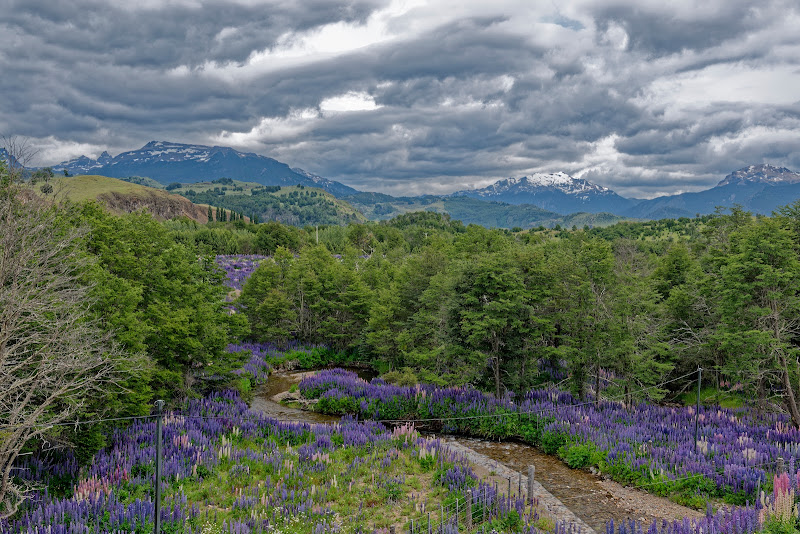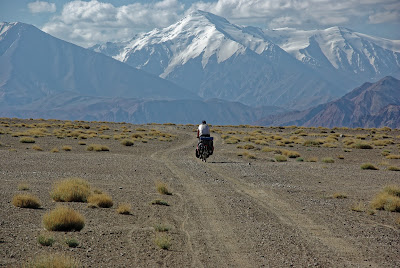Puyuhuapi, NP Queulat, Coyhaique, and Villa Cerro Castillo
Dec. 18th 2022 - NP Queulat - Glacier
Had a long lunch break in Puyuhuapi (settlement of German pioneers) and drove further along the shore to NP Queulat and its glacier. Hopefully the weather is fine early morning and I can see a bit on my hike. A first glimpse tonight through the lens of my (tele zoom) camera was promising.
History of Puyuhuapi
A group of Sudeten Germans were inspired by a book written by Hans Steffen and decided to emigrate to southern Chile. They were offered free land, but had to renounce their German citizenship in order to get it. The emigration was funded by a wealthy businessman, Robert Uebel, as a way to create an outpost for other settlers, but this plan was derailed by the war.
In 1935, Puyuhuapi was founded by Carlos Ludwig, Otto Uebel, Walter Hopperdietzel, and Ernesto Ludwig. They had to learn how to build a village from scratch, including clearing land and cutting trees for basic accommodations. They also learned how to raise pigs and do some agriculture and fishing.
The settlers of Puerto Cisnes initially relied on passing boats for equipment and supplies. They were offered 5,000ha by the Chilean government, but following the outbreak of war only 600ha was granted to them. To increase their land they assumed nominal public-sector duties which granted them 1,000ha. They started growing basic crops in 1936 and experimented with cattle, but it was not successful. By 1940 they had worked out how to raise cattle and produced a dairy which supplied cheese and butter to the village and Puerto Montt.
Chiloé labourers were hired in 1938 and in 1942 the first hydro-electric plant was built. The sawmill was upgraded with equipment from Osorno and timber became an important source of income. Finances were managed from Germany until the war, then shifted to Puerto Montt. Employees spent their salaries on provisions from a small store and Otto was the leader of the commune.
In 1947, Helmut Hopperdietzel and Ernesto's family moved to Puyuhuapi. In 1949 the settlers built a boat, and in 1951 Helmut set up a radio. In 1954 typhus spread through the village, but was stopped with antibiotics. In 1958 a fire destroyed the carpet factory, and it had to be rebuilt with a loan. An earthquake hit in 1960, and in 1964 there was a rat infestation that mysteriously ended when the rats all ran into the water and drowned.
In 1955-1956 the first formal education for children in Puyuhuapi began, and the first school was established in 1958. In 1966 the first Catholic church was constructed in Chilote style. In 1971 the Chilean state formally recognised Puyuhuapi. Two years later Pinochet's troops arrived, and one person was reportedly killed for having left-leaning tendencies. Father Ronchi began playing an increasing role in the village in the mid 1970s, building a small chapel at the cemetery, installing a radio antenna and television. TV stations then started to encrypt their signals, which led to the children picking up Mexican slang.
In 1982, Pinochet inaugurated the Carretera Austral which passed through Puyuhuapi and a regular bus service was established. Ursula opened Hosteria Alemana and Walter installed the first petrol station. Telephones arrived in 1988, state-operated electricity in 1989, cellphones in 2007 and internet in 2008. Parque Nacional Queulat was formed in 1983 and trails were opened in 1994. Casa Ludwig was declared a Historic Monument in 2011 and the landing strip was paved in 2012. The launch of Hopperdietzel beer took place in 2013.
Queulat National Park
Queulat National Park is a national park in Chile located in the Aysén del General Carlos Ibáñez del Campo Region. It contains 1,541 km2 of glacier-capped mountains and virgin evergreen forests. The largest glaciated area is Queulat ice cap and features attractions such as the Queulat Hanging Glacier, Cascada de Ventisquero Colgante waterfall, Queulat Sound, Father García and the Cóndor Falls, and Cat's Stone (Piedra del Gato).
Dec. 19th 2022 - Fresh Eggs
Villa Amengual and its bus restaurant, Melinda Sandwich.Mañihuales is a small town in Chile founded in 1962 which attracts mostly those looking for petrol. It is home to miners, who work at the Toqui mine producing zinc, lead, silver and gold. The area around it has been destroyed by logging, although there is a national reserve nearby. There are few services, no ATM or laundry and little to recommend for tourists. The main event of historical importance was the 1966 landslide, now largely forgotten.
My campsite today has a lot of active chicken, hope to get some fresh eggs from them in Villa Manihualis.
Dec. 20th 2022 - Coyhaique - rest day ahead
The Carretera Austral splits 12km south of Mañihuales into two roads both marked ‘Carretera Austral’: one towards Coyhaique and the other towards Aysén and Chacabuco. The Carretera Austral south of Mañihuales to Coyhaique is paved until 12km south of Aysén, after which it becomes a gravel road for 54km until the last 10km into Coyhaique. The route passes through beautiful valleys and agricultural regions and may have cattle or sheep on the road. The gravel surface is generally fine, but there are some steep ascents and descents that could be challenging. Heavy trucks servicing the farms use the road, which may lead to ruts in wet conditions.
Coyhaique
Coyhaique is the only major city along the Carretera Austral. It has grown to offer shopping, restaurants, hotels, tour operators, ATMs, garages, and a micro-brewery. Weather is usually pleasant in summer but raincoat is necessary all year. Pollution is a problem in winter due to wood-burning stoves. The city is safe and increasingly bohemian. Perfect for football fans: Bajo Marquesina is a soccer-themed bar in downtown Coyhaique offering great prices, large portions and a festive atmosphere. It has a football museum with memorabilia and photos, and is tiled with vintage jerseys.
Arrived in the big city today, nice camp site and a good opportunity to refill, wash, repair and take a day off. Now the southern part of Carreterra Austral is about to begin. With a few stops for sightseeing I should be on New Years Eve or a few days later in Villa O'Higgins, with a bit more then a month for the deep south left.
Dec. 22th 2022 - Snow - winter is coming
A day with fast changing weather, 15min sunshine, then rain and wind and on 1100m there was very strong winds and snow coming down. I changed my jacket about five times. Famous switchback curves down to Villa Cerro Castillo. A place with a view.
Villa Cerro Castillo
Villa Cerro Castillo is a village located on the Carretera Austral that serves as a gateway to a 180,000ha national reserve featuring jagged basalt peaks, trout-filled rivers, waterfalls, hanging glaciers, lagoons and native bush. It is becoming an increasingly popular destination for trekking and horseriding, with its dramatic approach offering vast panoramic vistas.
Dec. 23rd 2022 - As the wind blows...
The first 40km were quite demanding. Very ugly gravel, a lot of steep ascents ( and with washboard the descents are not much better) and a heavy headwind. Made it to a farm with camping and had cows and horses and chicken around my tent. Cool when the wind was blowing, got better by turning south. Ride from Villa Cerro Castillo alongside Río Ibáñez with views of Valle Ibáñez and the Cordillera Castillo. Climbed three hills before reaching Lago General Carrera, and prepared myself for ~500 kilometers of poor roads, sand, rocks and dust from now on.















































































